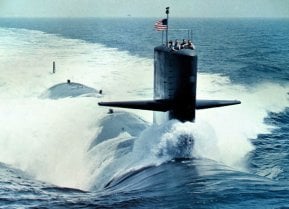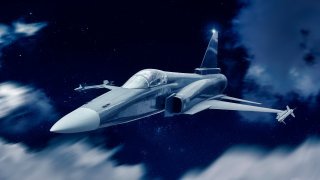F-20 Tigershark: The Greatest Fighter Jet That Never 'Flew'
The Northrop F-20 Tigershark is celebrated as the "greatest fighter never built." Originating from the F-5E Tiger II, the F-20 offered cutting-edge avionics, a GE F404 engine propelling it to Mach 2.1, and a versatile weapons loadout, including AMRAAM and Maverick missiles.
What You Need to Know: The Northrop F-20 Tigershark is celebrated as the "greatest fighter never built." Originating from the F-5E Tiger II, the F-20 offered cutting-edge avionics, a GE F404 engine propelling it to Mach 2.1, and a versatile weapons loadout, including AMRAAM and Maverick missiles.
-Designed as a low-cost export fighter under the FX program, it showcased modern features like multimodal radar, panoramic canopy, and rapid readiness. Despite its strong performance, the Reagan administration’s loosening of export restrictions on F-15s and F-16s sidelined the F-20.
-Though only three prototypes were built, its impressive potential continues to inspire what-if scenarios among aviation enthusiasts.
The F-20 Tigershark: A Fighter That Could Have Changed History
Northrop’s F-20 Tigershark has developed a bit of a fandom online as the greatest fighter never put into production. It was developed by the aerospace company at its own expense. Innumerable Reddit posts and YouTube videos celebrate the aircraft.
It offered excellent performance at a low cost. It was designed to be able to tangle with the latest Soviet fighters from beyond visual range, something that even the first-generation F-16 lacked. It boasted air-to-air and air-to-ground capabilities. It could handle the latest American armaments such as the first-generation Advanced Medium-Range Air-to-Air Missile (AMRAAM) air-to-air missile.
Northrop’s Slick Marketing Campaign
The defense contractor produced a slick advertisement featuring aeronautical legend, the late Brig. Gen. Charles “Chuck” Yeager, in an attempt to sway the Air Force brass into buying the plane.
The advertisement had the feel of a television commercial for the latest hot automobile.
“You’re on strip alert. A low-flying, high-speed intruder is detected 80 miles from your base. In the Tigershark you can respond faster than any other fighter in the world today with its self-contained cartridge starter the Tigershark’s engine reaches idle power in 19 seconds. Its laser inertial navigator aligns within 22 seconds to an accuracy of better than one nautical mile per hour with a clutter-free radar target display and targeting weapons firing capability,” the narrator says, building excitement about the aircraft.
Three prototypes were built. Of those, two crashed during sales tours, and the only surviving prototype is on display at the Science Center in Los Angeles.
The F-20 ultimately lost out in the bidding war with the General Dynamics F-16 Fighting Falcon that remains in front-line service today.
From the F-5G to the F-20: An Evolution of Concept
It began as an evolution of the F-5E Tiger II that boasted a more modern avionics package and originally was designated as the F-5G before being rebranded as the F-20 by the U.S. Air Force in 1982. Development began as part of the FX program aimed at providing a top-quality fighter for the export market after the Carter administration announced top American fighters would not be sold abroad. Consequently, smaller nations needed a deterrent against the Soviet fighters of the era, so Northrop took it upon itself to develop a fighter under the FX program starting around 1980.
Northrop saw the F-5 that was in use by countries that were friendly to the U.S. around the world. Consequently, it chose to upgrade that F-5 airframe with a single GE F404-GE-100 low bypass turbofan offering 17,000 pounds of thrust that could propel the F-20 to Mach 2.1 at 36,000 feet. The engine originally was designed for the F/A-18 Hornet. It had an operational ceiling of 55,000 feet and a climb rate of 52,800 feet per minute.
The Reagan administration’s loosening of export restrictions on front-line U.S. fighters such as the F-15 and F-16 spelled the F-20’s doom. Foreign customers chose to buy the F-15 and F-16 instead.
F-20: Punching Above Its Weight
Northrop countered by offering a more sophisticated avionics package that included a multimodal radar that was capable of tracking targets at 48 nautical miles “look up” and 31 nautical miles “look down.” The F-20 had a modern heads-up display similar to that found on the F/A-18.
“The F-20 could carry more than 8,300 pounds of external armaments and fuel on five pylons. It could carry six Sidewinder missiles on air-to-air missions. For air-to-ground missions, more than 6,800 pounds of armament could be carried. Two internally mounted 20mm guns were standard equipment on the Tigershark,” the FAS Military Analysis noted.
The F-20 was capable of carrying a wide variety of weapons including the entire range of Mark 80 series bombs, the AGM-65 Maverick air-to-ground missiles, and the AIM-9 Sidewinder and AIM-7 Sparrow air-to-air missiles.
The Tigershark’s small size meant that it could not carry as much in terms of weapons as the F-16 it competed against.
The pilot received a panoramic canopy compared with the F-5 it derived from, giving its pilot a wider field of view.
In an era of cost overruns and technological snafus, the F-20 Tigershark proved to be a low-cost jet fighter that punched above its weight. We can only wonder what might have been had the F-20 been greenlit.
About the Author: John Rossomando
John Rossomando is a defense and counterterrorism analyst and served as Senior Analyst for Counterterrorism at The Investigative Project on Terrorism for eight years. His work has been featured in numerous publications such as The American Thinker, The National Interest, National Review Online, Daily Wire, Red Alert Politics, CNSNews.com, The Daily Caller, Human Events, Newsmax, The American Spectator, TownHall.com, and Crisis Magazine. He also served as senior managing editor of The Bulletin, a 100,000-circulation daily newspaper in Philadelphia, and received the Pennsylvania Associated Press Managing Editors first-place award for his reporting.


